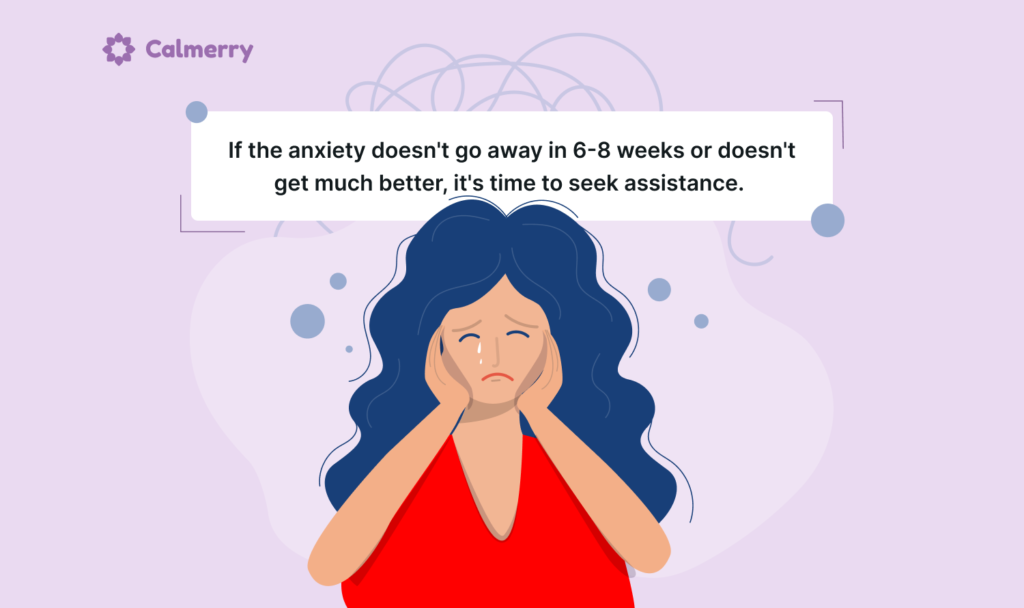How Do I Handle Anxiety During Major Life Transitions?

In this article
You’re unpacking the final box in the apartment, looking at the unfamiliar street in front of the new home. The stomach hurts, while you keep thinking: “What if it’s a mistake? What if I won’t adapt?” If it seems too familiar, then chances are, you’re experiencing anxiety during life transitions.
The anxiety afflicts millions annually as they experience significant changes. Beginning at a new workplace, ending a romance, having children, relocating, retiring, or facing a severe illness can often be overwhelming. In reality, 75–85% of adults feel more anxious during major life transitions. [1] Symptoms of Anxiety and Depression Among Adults: United States, 2019 and 2022 by Emily P. Terlizzi, M.P.H., and Benjamin Zablotsky, Ph.D. Publications and Information Products from the National Center for Health Statistics. (n.d.). https://www.cdc.gov/nchs/products/index.htm
But it’s a normal reaction. Change disrupts a feeling of control and consistency. These are 2 things that the mind requires in order for us to feel safe. That’s why good changes can stress us so much.
It offers real-world, evidence-based strategies for managing anxiety. It also covers when to seek professional help. And, it covers modern tools like online therapy that serve mental health in flux.
Let’s attempt to release these feelings by first investigating the reason why transitions induce overwhelming anxiety.
Understanding why transitions trigger anxiety
We strive for stability and consistency. These routines offer us safety and security. When routines are dislocated by a change, such as a job change, move, or breakup, the mind activates the sympathetic nervous system.
This part of the autonomic nervous system responds to the “fight-or-flight” reaction. The stress response activates the release of cortisol and adrenaline. The end result is the bodily symptoms of a racing heart, muscle tension, and obsessive thinking.
Coping with change begins by discovering how the mind and body respond to the unknown. Fearfulness is the natural response to something that’s seen as a threat. Whenever it’s a major change in life, the mind automatically perceives that change as a threat.
Life changes can also challenge our sense of identity and emotional security. Questions like “Who am I now?” or “Will I be okay?” create internal conflict that feels threatening on a psychological level. Even positive transitions often involve grief for what’s being left behind, familiar roles, people, or environments, thus adding emotional weight to the process.
But these reactions are normal and, for many people, short-term. Adjustment anxiety typically lasts between 2 and 4 weeks as routines stabilize and support is in place. However, if symptoms persist longer or interfere with daily functioning, it may indicate a more serious anxiety condition. [2] Marc, G., Mitrofan, L., & Vlad, C. (2024). The relationship between critical life events, psycho-emotional health, and life satisfaction among youths: coping mechanisms and emotional regulation. Frontiers in Psychology, 14, 1288774. https://doi.org/10.3389/fpsyg.2023.1288774
Responses vary depending on personal history, existing support systems, the type of transition, and prior stress management techniques. Some individuals adapt quickly, while others require more time and resources to stabilize.
Practical strategies for managing anxiety in the moment

When anxiety hits during a major transition, the goal is to regain control quickly. Fortunately, there are proven stress management techniques that can help stabilize both body and mind. These methods are simple, accessible, and effective for managing anxiety as it arises in real time.
- One of the most immediate ways to interrupt anxious spirals is through grounding. The 5-4-3-2-1 method uses your senses to anchor you in the present: Look for 5 things you can see, touch 4 different textures, listen for 3 distinct sounds, identify 2 scents, and notice 1 thing you can taste. This shifts attention away from future fears and back into the current moment.
- Another fast-acting tool is diaphragmatic breathing. Sit comfortably and place one hand on your chest, the other on your belly. Inhale through your nose for 4 counts, making sure the belly rises more than the chest. Hold your breath for 4 counts, then exhale slowly through your mouth for 6 counts. Repeat this cycle 5 to 10 times to reduce heart rate and tension.
- Alongside physical regulation, cognitive tools are essential for calming mental overwhelm. Start by challenging catastrophic thoughts, which are worst-case scenarios that feel all-consuming. If you find yourself thinking, “What if I completely fail?”, reframe it with a more realistic view: “This is a challenge, but I’ve handled uncertainty before.”
- Another technique is thought stopping, which helps break the loop of spiraling worries. When you notice an anxious thought gaining speed, firmly say “STOP” either aloud or in your mind. Then, immediately redirect your attention to a grounding or physical activity.
- Mindfulness can also be a powerful ally. Rather than reacting to thoughts or sensations, observe them without judgment. Focus on what’s happening now, including your breath, your surroundings, and your body, rather than what might happen in the future.
- Physical movement is equally important. Progressive muscle relaxation involves tensing each muscle group for 5 seconds and then releasing. Start at your toes and move upward: feet, calves, thighs, abdomen, hands, arms, shoulders, neck, and face. This helps discharge built-up stress from the body.
- Even brief activity matters. Just 10 to 15 minutes of walking, stretching, or light exercise can significantly lower cortisol and elevate endorphins, improving mood and reducing anxiety symptoms.
These stress management techniques are backed by research. Clinical studies show that consistent use of breathing, mindfulness, and muscle relaxation techniques can reduce anxiety symptoms by up to 60%. [3] Manzoni, G. M., Pagnini, F., Castelnuovo, G., & Molinari, E. (2008). Relaxation training for anxiety: a ten-years systematic review with meta-analysis. BMC Psychiatry, 8(1), 41. https://doi.org/10.1186/1471-244x-8-41 Practicing them regularly, especially during stressful transitions, can provide reliable, fast-acting relief.
Building long-term resilience: coping with change
While short-term techniques help manage anxiety in critical moments, long-term stability depends on developing habits that strengthen resilience. Sustained coping with change requires structure, self-compassion, realistic expectations, supportive relationships, and healthy daily practices.
Creating predictable routines provides stability amid uncertainty. Consistent wake and sleep times, regular meals, designated work periods, and intentional relaxation help the brain reestablish order. Neurologically, routines reduce decision fatigue, allowing more energy for managing anxiety during transition stress.
Equally important is self-compassion, which means treating yourself with the same kindness you would offer a friend. Replace thoughts like “I should be handling this better” with “This is difficult, and it’s okay to struggle.” Self-compassion includes 3 elements: self-kindness, recognition of common humanity, and mindfulness, all shown to lower stress and support adjustment.
Setting realistic expectations also eases the process. In fact, full adaptation to major life changes often takes 3 to 6 months. [4] Luhmann, M., Hofmann, W., Eid, M., & Lucas, R. E. (2011). Subjective well-being and adaptation to life events: A meta-analysis. Journal of Personality and Social Psychology, 102(3), 592–615. https://doi.org/10.1037/a0025948 Break transitions into smaller, achievable steps and celebrate gradual progress rather than expecting immediate comfort.
Social support plays a biological role in resilience. Meaningful connection releases oxytocin, which lowers cortisol and dampens stress responses. Schedule regular check-ins, share specific needs, or join transition-related groups. Overcoming barriers such as fear of burdening others or pride strengthens emotional balance.
Foundational health practices sustain the body’s stress tolerance. Maintain sleep hygiene with 7-9 hours nightly, consistent sleep times, and limited screen use before bed to prevent the anxiety-insomnia cycle. Eat balanced meals with protein and complex carbohydrates to stabilize blood sugar and avoid symptoms that mimic anxiety. Incorporate at least 30 minutes of moderate physical activity daily to lower anxiety hormones and boost mood-regulating neurotransmitters.
When to seek professional support: life transition therapy

If the anxiety doesn’t go away in 6-8 weeks or doesn’t get much better, seek assistance. Consider consulting a professional from Calmerry if it disrupts relationships or employment, disrupts eating or sleeping, leads to recurring illness, leads to chemical or drug addiction, or includes hopelessness or suicidal thinking.
Seeking professional anxiety support is a sign of self-awareness and resilience, not weakness. Therapy provides structured guidance when personal strategies are no longer sufficient. Life transition therapy is a specialized approach for people facing significant life changes. It focuses on processing grief for what’s left behind, developing personalized coping strategies, rebuilding identity and confidence, and preparing for ongoing adjustments.
Therapists use evidence-based methods to reduce anxiety and improve adaptability. Cognitive Behavioral Therapy (CBT) helps identify and reframe anxious thought patterns while promoting adaptive behaviors. Acceptance and Commitment Therapy (ACT) teaches individuals to accept uncomfortable emotions and act in line with personal values. Narrative therapy allows clients to reinterpret transitions as meaningful chapters in their life story, fostering coherence and self-growth.
A typical course of life transition therapy lasts 8-16 sessions for situational anxiety. It includes assessment, goal-setting, emotional processing, skill-building, and relapse prevention. Between sessions, clients may complete journaling, coping exercises, or behavioral experiments to reinforce progress.
Structured therapy reduces anxiety symptoms in 60-80% of patients, with CBT and ACT among the most effective treatments. [5] Philip C. Kendall, Ph.D., Jeremy S. Peterman, M.A. CBT for Adolescents With Anxiety: Mature Yet Still Developing Focus 2017; 15:227–239; doi: https://psychiatryonline.org/journal/foc Therapy provides both immediate relief and long-term tools for managing future transitions with stability and confidence.
Introducing online therapy for anxiety disorders
Online therapy, such as Calmerry, provides professional anxiety support through the convenience of online platforms. The decision is made either by video, messaging, or by phone consultations. The standard of care is no different than in-office visits. The decision is more practical and appropriate for individuals managing anxiety during major changes in lifestyle.
Accessibility is one of its main advantages. Sessions can be held from any location with an internet connection, eliminating travel barriers during relocation, new jobs, or caregiving changes. Flexible scheduling allows clients to integrate therapy into shifting routines, and average wait times are shorter, about 2-3 weeks, compared to 6-8 weeks for traditional therapy.
Research confirms the effectiveness of online treatment: studies show online Cognitive Behavioral Therapy (CBT) achieves anxiety symptom reduction comparable to face-to-face therapy, with efficacy rates around 70–80%. [6] Kumar, V., Sattar, Y., Bseiso, A., Khan, S., & Rutkofsky, I. H. (2017). The effectiveness of Internet-Based Cognitive Behavioral therapy in treatment of psychiatric disorders. Cureus, 9(8), e1626. https://doi.org/10.7759/cureus.1626 Evidence-based approaches and the therapist–client relationship remain equally strong regardless of delivery format.
Online platforms offer several communication options. Video sessions closely replicate in-person interaction through verbal and non-verbal cues. Messaging therapy supports written reflection for clients who process best in writing. Phone sessions suit those who prefer voice-only communication or have limited bandwidth. Many services combine these modalities for a personalized experience.
Therapist matching is another benefit. Large online networks increase the likelihood of finding specialists in both anxiety disorders and life transition therapy. Matching typically involves completing a questionnaire covering symptoms, goals, and preferences, with the option to switch therapists if the fit isn’t ideal.
From a practical standpoint, online therapy is often 20–40% more affordable than in-person care. Many platforms accept insurance or provide sliding-scale fees. All major providers use HIPAA-compliant systems with encrypted data to ensure privacy. Only a smartphone or computer with internet access is required.
Getting started involves a brief intake process. For example, in Calmerry, you need to complete an assessment, review therapist matches, schedule your first session, and prepare by identifying main stressors or goals. Online anxiety therapy offers a flexible, evidence-based path for managing anxiety and maintaining emotional stability through major life transitions.
Turning change into growth

Experiencing anxiety during life transitions is a universal part of being human. It affects people of all ages, backgrounds, and professions, often arising when life demands adaptation faster than we expect. These feelings are a normal response to uncertainty.
Anxiety during major changes is temporary and manageable. Evidence-based techniques provide relief in difficult moments, while building long-term resilience strengthens stability throughout transitions. Professional anxiety support, including life transition therapy, offers effective guidance, and online options now make that help more accessible than ever.
Successfully coping with change is a skill that can be developed through consistent practice and appropriate support. While transitions may feel overwhelming at first, they often lead to stronger self-awareness, adaptability, and personal growth.
If your anxiety is difficult to manage, start small. Start with 1 or 2 of these methods. You can get professional help as well. Online therapy is a convenient, private, and flexible way to start.
Symptoms of Anxiety and Depression Among Adults: United States, 2019 and 2022 by Emily P. Terlizzi, M.P.H., and Benjamin Zablotsky, Ph.D. Publications and Information Products from the National Center for Health Statistics. (n.d.). https://www.cdc.gov/nchs/products/index.htm
Marc, G., Mitrofan, L., & Vlad, C. (2024). The relationship between critical life events, psycho-emotional health, and life satisfaction among youths: coping mechanisms and emotional regulation. Frontiers in Psychology, 14, 1288774. https://doi.org/10.3389/fpsyg.2023.1288774
Manzoni, G. M., Pagnini, F., Castelnuovo, G., & Molinari, E. (2008). Relaxation training for anxiety: a ten-years systematic review with meta-analysis. BMC Psychiatry, 8(1), 41. https://doi.org/10.1186/1471-244x-8-41
Luhmann, M., Hofmann, W., Eid, M., & Lucas, R. E. (2011). Subjective well-being and adaptation to life events: A meta-analysis. Journal of Personality and Social Psychology, 102(3), 592–615. https://doi.org/10.1037/a0025948
Philip C. Kendall, Ph.D., Jeremy S. Peterman, M.A. CBT for Adolescents With Anxiety: Mature Yet Still Developing Focus 2017; 15:227–239; doi: https://psychiatryonline.org/journal/foc
Kumar, V., Sattar, Y., Bseiso, A., Khan, S., & Rutkofsky, I. H. (2017). The effectiveness of Internet-Based Cognitive Behavioral therapy in treatment of psychiatric disorders. Cureus, 9(8), e1626. https://doi.org/10.7759/cureus.1626
online therapy
live video session



